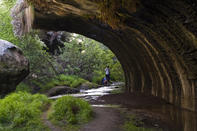Capital City
Fouriesburg lies within the territory disputed by the Basotho under Moshoeshoe I, resulting in the Basotho wars of 1858, 1865 and 1867. In terms of the Treaty of Thaba Bosiu, signed in 1866 by Chief Paulus Mopeli (Moshoeshoe's brother), the areas of Fouriesburg, Clarens, the Little Caledon River and Witsieshoek were awarded to the Orange Free State.

Fouriesburg also figured in the South African War: following the occupation of Bloemfontein by British forces in March 1900, the Boer forces fell back to the Brandwater Basin, establishing a provisional government at Fouriesburg and making the town their headquarters. The British sealed off five of the six passes giving access to the basin and encountered little resistance from the Boers when they attacked Slabberts Nek on 23 July.
The only remaining exit, the Golden Gate, was sealed off on 28 July and the following day General Marthinus Prinsloo and 4 300 men surrendered. About 20 km east of Fouriesburg, a memorial to the British and Boer forces killed in battle marks the site of Surrender Hill, where the Boers laid down their arms. General JH Olivier, however, refused to recognise the surrender and escaped with 1 500 men through the Golden Gate. In Fouriesburg itself is the house where President Marthinus Steyn lived during the town's brief tenure as a capital city.